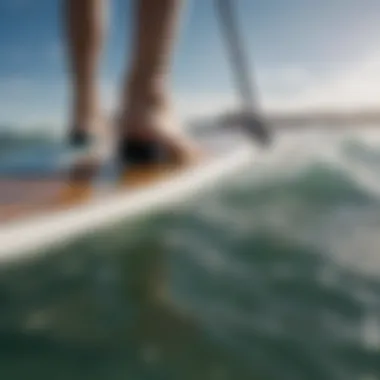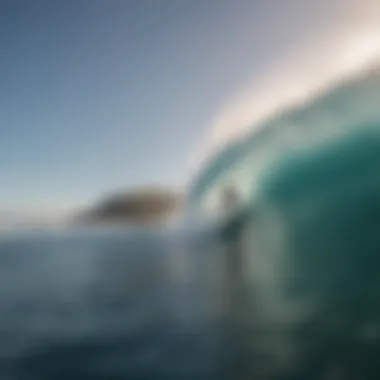Exploring the World of Standing Up Boards


Intro
Standing up boards have transformed from niche sporting equipment into a cultural phenomenon. They draw enthusiasts from all walks of life, offering both a thrilling ride on the waves and a serene connection with nature. These boards serve not just as tools for surfing or paddleboarding but also as symbols of an active and adventurous lifestyle. Let’s delve into the various facets of these boards, their significance, and what one needs to know to ride the waves.
Surf Gear and Equipment
The right gear is essential for any surfer looking to master the waves. Understanding the latest developments in surfboard technology can make a world of difference.
Latest Surfboard Technologies
In the fast-evolving world of surfing, innovation is key. Modern boards are being crafted from advanced materials like epoxy and carbon fiber, enhancing their strength and buoyancy. Here are some noteworthy advancements:
- Lightweight Designs: New materials reduce overall weight without sacrificing durability.
- Hydrodynamic Shapes: Shapers are experimenting with contours that maximize speed and control, allowing for deeper carving and smoother turns.
- Eco-Friendly Options: There’s been a shift toward sustainable practices in production. Companies are now sourcing materials that minimize environmental impact.
These technologies not only improve performance but also enhance the overall surfing experience.
Essential Accessories for Surfers
Beyond just the board, having the right accessories is crucial. Here’s a list of must-haves:
- Leash: Keeps you attached to your board, ensuring you don’t lose it in the surf.
- Wax: Provides grip between your feet and the board, crucial for preventing slips.
- Board Bag: Protects your board while transporting and storing.
- Safety Gear: Consider a wetsuit or impact vest depending on conditions.
Equipping yourself with these items can greatly enhance your time in the water.
Techniques and Skills
Developing the right techniques is as important as having good gear. Mastery over skills ensures not just performance but safety too.
Wave Riding Strategies
Riding waves is an art. Beginners often struggle with timing and positioning. Here are some strategies to help:
- Paddling Technique: A strong, efficient paddle stroke is essential for catching waves effectively.
- Stance and Balance: Finding your balance on the board will make maneuvering much easier. Start with a shoulder-width stance, keeping your knees slightly bent.
- Reading the Ocean: Understanding wave patterns, tides, and wind conditions can significantly impact your ride.
Safety and Surf Etiquette
Surfing is as much about respect as skill. Every surfer should be aware of the unwritten rules that govern the waves. Here’s a concise guide:
- Know Your Limits: Don’t paddle out in conditions you’re not ready for.
- Respect Local Surfers: Every spot has its own set of surfers. Be mindful and respectful of the locals – they often are more experienced.
- Watch Your Line-Up: Don’t drop in on someone else's wave. Wait for your turn; it’s all about sharing the ocean.
"Safety on the waves starts with respect for your fellow surfers and for the ocean itself."
Understanding these fundamentals not only enhances your experience but also promotes a positive atmosphere among surfers.
Prelims to Standing Up Boards
Standing up boards, which are often linked with the exhilarating activities of paddleboarding and surfing, have carved out a significant niche in aquatic sports. Their importance isn't merely about riding waves; it's deeply rooted in wellness, social interaction, and connection with nature. Understanding this realm is critical for both beginners and seasoned adepts. Whether you're contemplating your first board purchase or looking to sharpen your skills, grasping the nuances surrounding standing up boards can substantially enhance your experience.
These boards are not just large pieces of foam or fiberglass; they represent a lifestyle choice. People have started embracing paddleboarding and surfing not only for the thrill but also for the myriad benefits—physical fitness, mental focus, and even environmental awareness that comes with engaging in these water sports. The joy of gliding over water's surface while maintaining balance can hardly be framed in words. It’s a dance with nature, one that requires both physical agility and mental acuity.
Key Elements to Consider
When delving into the world of standing up boards, certain factors are crucial:
- Purpose: Are you looking to peacefully explore a calm lake or tackle white-capped ocean waves? This will influence the kind of board that suits your needs.
- Experience Level: Newcomers may benefit from wider, more stable boards, while experienced surfers might lean towards performance-focused models.
- Environmental Considerations: Understanding the ecological impact of your choice of gear—both in regards to production and use—can inform better decisions not just for your experience but for the environment as well.
Why This Matters
This article endeavors to strip away the complexities surrounding standing up boards, presenting a clearer picture that encompasses their evolution, types, and cultural relevance. Also, exploring maintenance and health benefits reveals their importance beyond sport.
"Knowing your board is like knowing your home. It’s not just a tool; it’s an extension of yourself on the water."
By empowering readers with this knowledge, enthusiasts can glide into the water with confidence and purpose, creating not just a sport practice, but a lifestyle rooted in adventure and mindfulness.
Historical Background
Understanding the historical background of standing up boards paints a vivid tapestry of how these vessels came to occupy a vital spot in aquatic sports culture. By tracing their evolution, we not only appreciate the craftsmanship involved but also recognize their cultural significance and community ties. The importance of this history is amplified when one considers how it guides contemporary practices, shapes modern designs, and influences current techniques. There's a story embedded in the very shape of the board, its material, and the way it is used in waves – each piece of lore builds the solid foundation of what standing up boards represent today.
Early Developments
The journey of standing up boards can be traced back to ancient Polynesian cultures. These early seafarers crafted boards from wood, using local materials available to them. As they paddled across vast oceans, they not only traveled but also connected with their environment on a profound level. This relationship manifested in the design of their boards, which were often long and narrow, allowing for superior buoyancy and speed in gliding over waves.
The Hawaiian islands later played a pivotal role in the development of the modern surfboard. Surfing, or "he'e nalu" in Hawaiian, was not just a pastime but a spiritual practice, giving rise to the notion that riding waves was akin to dancing with the ocean. Traditional boards were made from local trees, specifically the koa wood, known for its strength and resilience. The artistry involved in these early designs set a standard for future generations of board-makers.
Cultural Significance
The cultural importance of standing up boards extends far beyond the realm of sports, serving as a symbol of unity, freedom, and self-expression.
Hawaiian Influence
Hawaiian influence on standing up boards is unmatched. Here, we see surfing deeply intertwined with cultural identity. The key characteristic of Hawaiian influence lies in its focus on holistic connection—with the ocean, the board, and oneself. This unique feature has transformed surfing into a lifework for many, emphasizing respect for nature and community.
Moreover, Hawaiian traditions have paved the way for sustainable practices in board-making. Many local artisans prefer to use eco-friendly materials that echo the ancient methods, ensuring minimal disruption to their surroundings. This respect for both history and environment is a primary reason for its popularity in today’s surfing practices.
The connection between the Hawaiian people and the sea is profound; it has roots in their culture and spirituality, serving as a testament to the importance of maintaining harmony with nature.


Modern Popularity
In contemporary times, the modern popularity of standing up boards can be traced to a renaissance of interest in both physical fitness and mindfulness, coupled with an increased accessibility to water sports. With the rise of alternatives like paddleboarding, which emphasizes stability and ease, new users are drawn to water sports, valuing both its physical and mental benefits.
A unique feature of its current popularity is the versatility of different board types. From paddle boards to surfboards, there’s something for everyone, regardless of skill level. This inclusivity may contribute to its continuing benefits, fostering community events and competitions that celebrate inclusivity and innovation within the surfing culture.
Yet, alongside this surge in popularity, there's an ongoing discussion about commercialization. The advent of mass-produced boards can lead to a loss of the craftsmanship and cultural heritage that these boards symbolize. Balancing tradition with modernity remains a vital conversation within this space, as enthusiasts and communities seek to preserve the essence while embracing change.
Types of Standing Up Boards
The world of standing up boards encompasses a variety of styles and designs, each tailored for diverse needs and activities. Understanding these differences is crucial to enhancing the experience of anyone involved, be it a newbie or a seasoned surfer. Choosing the right board not only boosts performance but also plays a significant role in personal comfort and enjoyment on the water.
Paddle Boards
Paddle boards have seen a surge in popularity, and it's not hard to see why. They offer a unique blend of serenity and excitement. Often wider and more stable than traditional surfboards, paddle boards cater to a variety of activities beyond just surfing. This versatility allows users to embark on leisurely explorations or intense workouts. The stability factor makes them a compelling choice for beginners who may still be finding their balance.
When it comes to paddle boards, they often come in two main types: all-around and touring.
- All-around boards: good for beginners and versatile for different water conditions.
- Touring boards: longer and narrower, designed for speed on flat water.
Whether used for fitness, leisurely outings, or catching a few waves, paddle boards provide an entry point into the wider world of standing up boards.
Surfboards
Surfboards are the chameleons of the standing up board world. With such variety, they don’t just cater to different surfers but are also custom-tailored to different surfing conditions. At a glance, surfboards can be broadly classified into three prominent styles: shortboards, longboards, and fish boards.
Shortboards
Shortboards deserve a special mention in any conversation about surfing. These compact boards, usually measuring between 5’5" to 6’5", allow for sharper turns and quicker maneuvers. Their design is geared towards performance, making them incredibly popular among advanced surfers who want to ride bigger, steeper waves. The key characteristic here is their width; they are thinner and streamlined, which helps achieve high speeds.
Advantages of shortboards:
- Faster response on waves.
- Ideal for aggressive maneuvers.
Disadvantages include:
- Less stability for beginners.
- Can be challenging in smaller waves.
Longboards
Longboards offer a retro vibe that appeals to many surfers. These boards typically run between 8’ and 12’, creating a stable platform that is perfect for catching smaller waves with ease. The major highlight of longboards is their capacity to glide smoothly, making them a preferred option for those who appreciate a more relaxed style of riding.
They are often viewed as a beneficial choice for beginners and recreational surfers since they allow for a smoother balance and easy paddling.
Unique features include:
- A wide nose for enhanced stability.
- Ability to perform classic maneuvers like nose riding.
However, they can be bulky and more challenging to control in strong wave conditions.
Fish Boards
Fish boards are intriguing hybrids that combine elements from both shortboards and longboards. Typically shorter and wider than traditional shortboards, they have a distinct swallow tail shape which aids in gliding. This design allows for additional buoyancy in smaller waves, making them highly sought after for surfers wanting that mix of performance and playfulness.
Their unique characteristics allow them to slice through water effortlessly, which is an advantage when conditions aren't ideal for traditional shortboarding.
Benefits of fish boards:
- Great for low-energy waves.
- Excellent speed and maneuverability.
Their drawbacks:
- Not as responsive in larger waves compared to shortboards.
Hybrid Models
Hybrid models are becoming more prominent as they blend features from different board types, appealing to surfers looking for flexibility without having to invest in multiple boards. These designs often incorporate the stability of paddle boards or longboards alongside the performance aspects of a shortboard or fish board.
A classic example of a hybrid board could be a funboard, which sits comfortably between the typical longboard and shortboard, catering to both novice and experienced surfers alike. They are versatile, meaning if conditions change, you don’t necessarily have to swap your board.
The flexibility of hybrid models facilitates a seamless surfing experience across varied water conditions, allowing riders to confidently navigate different challenges that the surf presents.
With an understanding of these types of standing up boards, surfers can make informed choices, aligning their equipment with their skills and the water conditions they encounter. Each board serves not just as a means to ride the waves, but also as an extension of surf culture, promoting everything from recreation to community and adventure.
Choosing the Right Board
Selecting the proper standing up board can significantly impact one's experience on the water. It’s akin to choosing a trustworthy companion for a long journey. The wrong choice could lead to frustration, ineffective paddling, or even safety hazards. A well-suited board not only enhances performance but also aligns with one’s skill level and the conditions in which one plans to paddle or surf.
When diving into the sea of options available, considerations break down into several critical components. (1) Skill Level is paramount. Beginners can find solace in wider and more stable boards, which offer reassurance as they navigate the waves and hone their paddling technique. In contrast, intermediate and advanced surfers might seek maneuverability and speed, which thinner and shorter boards provide.
(2) Types of Waves and Conditions matter too. Boards differ in various aspects such as length, width, and material. Understanding the local surf conditions—are they choppy, or is it glassy?—can determine how well a board performs. Picking a board tailored to these factors ensures a more enjoyable and fulfilling experience. Here, it is worth remembering:
"The right board can be the difference between riding the crest of the wave and wiping out end over end."
Hence, making informed decisions is crucial, and that leads to the next segment of this conversation.
Skill Level Considerations
As we delve deeper into skill level considerations, let’s explore what differentiates beginners, intermediate, and advanced users. Beginners typically benefit from boards that prioritize stability over speed, such as paddle boards around 10-12 feet long. An excellent option for novices is the All Around Paddle Board. It’s versatile, offering more stability on calm waters while still performing adequately in light surf.


For those who’ve mastered the basics, transitioning to an Intermediate Surfboard leads to better control and handling. Generally, it comes in the range of 8-10 feet. These anglers can afford to experiment with the dimensions, depending on their comfort with varying styles. Finally, for the pros out there, choosing a Performance Board, which is generally about 5-7 feet, allows for spectacular turns and tricks on aggressive rides.
The journey from beginner to expert also includes refining paddling techniques, reading waves, and honing balance. Evaluating personal capabilities before selecting the board illuminates the path to improvement.
Types of Waves and Conditions
Understanding the types of waves and their corresponding conditions is crucial for any surfer or paddler. When pondering which board could ride the waves smoothest based on the given conditions, one must consider factors such as the sea state, weather conditions, and wave types.
- Flat Water Conditions: If one is gliding on calm lakes or rivers, a Paddleboard known for stability is ideal. For long distances, a narrower board aids in speed.
- Small Wave Conditions: Catching smaller waves can be fun and requires a different strategy. A fun shape or minimal rocker allows for smooth paddling and easier glides.
- Big Wave Conditions: Surfers often rely on shortboards designed for steep, fast waves. These boards are lighter and shorter, allowing for agile maneuvers.
An often overlooked point: Not all boards perform equally across wave types. Knowing your environment not only enhances performance but reduces risks. An informed selection can mean catching waves like a pro or enduring a day of mishaps.
Techniques for Mastery
Mastering techniques for standing up boards is akin to crafting a fine art. This section dives into the nuances that not only improve performance but also make the experience more enjoyable. Each technique offers various benefits, from enhancing stability to boosting paddling efficiency. Integrating these techniques into practice can significantly elevate a rider's skills.
Balance and Posture
Balance is the bedrock of all successful movements on a standing up board. Like walking a tightrope, maintaining balance requires a keen sense of your core strength and body alignment. Proper posture can directly influence stability.
- Feet Positioning: Keep your feet shoulder-width apart, ideally centered on the board for optimal balance. This position helps distribute weight evenly.
- Knees Slightly Bent: Rather than standing stiffly, flexible knees can absorb the board's movements, making it easier to respond to waves.
- Upper Body Alignment: Engage your core and maintain an upright torso. Leaning slightly forward can help in keeping the momentum
"Balance isn't just about physical steadiness; it also reflects the harmony between body and movement."
Practicing balance drills, such as standing on one leg or using balance boards on land, can enhance your stability on the water. Over time, muscle memory will develop, leading to a seamless riding experience.
Paddling Techniques
Paddling is often overlooked, yet it is the heartbeat of effective standing up boarding. Employing correct paddling techniques can enhance speed and control while reducing fatigue.
- Grip and Hold: Hold the paddle with one hand on the top and the other on the shaft. Your top hand should pull back while the lower hand pushes forward effectively.
- Stroke Mechanics: Utilize long, smooth strokes. Dip the blade into the water near your feet and pull it back to your hips for maximum efficiency.
- Body Rotation: Incorporate your torso in the paddling motion. Twisting your upper body instead of merely using your arms will engage larger muscle groups, delivering more power with each stroke.
In addition, practicing reverse and sweeping strokes is crucial for maneuverability, especially when navigating through tricky waters or sharp turns.
Wave Riding Strategies
When it comes to wave riding, knowledge and instinct play significant roles. Understanding various strategies can turn an average ride into a thrilling experience.
- Reading the Wave: Get familiar with the wave dynamics—knowing when it peaks and how it breaks can inform your approach. Watch how waves shape up and mark spots where you can catch them.
- Timing and Positioning: Timing your take-off is critical. Paddle vigorously to match the wave's speed. Positioning yourself at the right moment can make or break your ride.
- Board Control: Keep your weight shifted slightly back when riding to maintain speed. Leaning into the wave will help maintain balance during your ride.
By practicing these strategies regularly, one can cultivate an instinctive feel for the waves, leading to more successful and rewarding experiences.
With commitment to these techniques, any rider can expect noticeable improvements in their skills. Focus, practice, and a willingness to adapt are fundamental components to achieve mastery on standing up boards.
Maintenance of Standing Up Boards
Taking care of your standing up boards is crucial for prolonging their lifespan and ensuring optimal performance on the water. Regular maintenance can help you avoid costly repairs, while also enhancing your overall experience. Whether you prefer paddleboarding on tranquil lakes or surfing the waves at your local beach, understanding how to care for your board can make all the difference.
Routine Care
Daily upkeep involves simple practices that ensure your board remains in top shape. After each use, rinse your board with fresh water to eliminate salt and sand that can prematurely wear down the materials.
- Cleaning: A gentle cleanser specifically designed for boards can help lift dirt without harming the surface. Avoid abrasive materials; they can scratch and weaken your board.
- Drying: Always dry your board thoroughly before storing it. This prevents mildew and other harmful conditions from forming on the surface.
- Storage: When not in use, store your board in a cool, shaded area to protect it from UV rays. Over time, sunlight can lead to fading and eventual material breakdown.
Invest in a good quality board bag for transportation and storage. It not only protects your board from physical damage but also shields it from harsh environmental factors.
Repairs and Damage Control
Accidents happen, and at times your board might suffer from dings or deeper damages. Addressing these issues quickly can prevent further deterioration and ensure safety while on the water.
- Inspect Regularly: Check for cracks or chips after every outing. Minor issues, if left unfixed, can lead to more severe damage.
- DIY Repairs: For minor surface damage, a repair kit developed for your board is often sufficient. Many kits include resin and sandpaper, enabling you to patch small dings easily.
- Professional Help: If you notice a significant structural issue, like a delaminated surface or major cracks, it’s wise to consult a professional. They can provide the expertise needed to fully restore your board.
"Taking the time to maintain and repair your standing up board can lead to a far richer experience in the water, ensuring that your adventures remain as exhilarating as they should be."
To avoid damage altogether, be mindful of where you paddle or surf. Refrain from using your board in rocky or challenging conditions unless you're adequately prepared.
Health Benefits of Standing Up Boarding
Standing up boarding, whether it's paddleboarding or surfing, has developed a strong reputation for not only providing a thrilling adventure but also offering numerous health benefits. For enthusiasts and casual users alike, understanding these benefits can enhance their experience, perhaps even encouraging a deeper commitment to this sport. Let's explore how this activity can positively impact both physical fitness and mental well-being.
Physical Fitness
Engaging in standing up boarding is more than a leisurely day on the water; it's a full-body workout that significantly enhances physical fitness. The act of paddling requires substantial upper body strength, as your arms and shoulders pull the paddle through the water. Simultaneously, you engage your core muscles as you strive to maintain balance on a board that is often shifting and moving.
A beginner may not notice it right away, but after a day on the water, the muscle fatigue is an undeniable reminder of the workout received. Here are key points to consider about the physical aspects:
- Cardiovascular Health: Paddling consistently elevates the heart rate, improving heart health over time.
- Strength Building: Regular sessions strengthen not only the arms but also the legs and back, thanks to the balancing act and paddling motions.
- Flexibility Enhancement: The dynamic movements involved in standing up boarding promote joint mobility and muscle flexibility.
- Stamina Improvement: As one continues to engage in this sport, overall stamina noticeably increases, allowing for longer sessions on the water without fatigue.
With each session, you're not just enjoying nature; you're sculpting a healthier you.
Mental Well-Being
Beyond the physical benefits, standing up boarding provides significant mental health advantages that should not be overlooked. The combination of fresh air, sunlight, and the calming presence of water can create a profound sense of peace. For many, getting out on the water becomes an essential practice for mental clarity.
Many surfers, for instance, speak of the enchanting "flow state" while riding the waves. This state of mind allows for a rare disconnect from the daily grind and stresses of life. Here are some notable mental health benefits related to this activity:


- Stress Reduction: Engagement with nature has been shown to lower cortisol levels, the hormone associated with stress.
- Enhanced Mood: Physical activity is linked with the release of endorphins, which can uplift your mood and promote feelings of happiness.
- Focus and Concentration: Standing up boarding requires attention and concentration, which helps improve mental focus over time.
- Promotes Mindfulness: Being out on the water encourages a mindful state, fostering a deeper connection with oneself and one's environment.
"In every drop of water, there is a story of life." - Anton Chekhov
Environmental Considerations
The rapid growth of paddleboarding and surfing has put a spotlight on the ecological footprint of these activities. As awareness about climate change and ocean health rises, understanding the environmental considerations tied to standing up boards becomes paramount for both practitioners and enthusiasts.
Many surfers and paddleboarders enjoy the outdoor lifestyle, but it’s crucial that this community takes steps to ensure that these natural wonders remain pristine for future generations. The combination of recreational enthusiasm and a commitment to protecting our environment can forge a powerful alliance. An audience that cares about sustainability will not only preserve their local beaches but also become advocates for larger global practices.
Sustainable Practices
When we talk about sustainable practices in the realm of standing up boards, we refer to the conscious efforts made by the community to minimize their environmental impact. This includes aspects like:
- Material Choice: Choosing boards made from eco-friendly materials is key. Many brands now utilize recycled plastics and sustainable wood sources, making it easier for surfers and paddleboarders to align their passion with their principles.
- Responsible Manufacturing: Companies that are transparent about their manufacturing processes and prioritize low-emission techniques contribute positively against environmental degradation.
- Eco-Conscious Accessories: Supporting brands that provide sustainable accessories�—like biodegradable leashes and recycled board bags—is an easy change that can add up significantly over time.
Incorporating these sustainable practices into the lifestyle not only helps protect our oceans but also fosters a sense of community responsibility. Each small step contributes to a larger narrative of environmental stewardship and ensures we embrace a culture of care rather than exploitation.
"The greatest threat to our planet is the belief that someone else will save it."
– Robert Swan
Protecting Marine Ecosystems
While enjoying the thrill of the waves, it is vital to engage in practices that protect the delicate marine ecosystems. The ocean is a complex web of life that requires careful stewardship. Here are a few thoughtful actions we can adopt:
- Awareness of Local Wildlife: Familiarizing oneself with local species, from coral to marine mammals, can enhance respect for the ecosystem. Knowing which areas are breeding grounds or habitats can help avoid disturbance.
- Minimizing Pollution: Simple practices like avoiding single-use plastics at the beach and taking trash back home make a significant difference. Even microplastics released into the water through some gear can contribute to broader issues.
- Educating Others: Sharing knowledge about the importance of marine ecosystems with fellow surfers and paddleboarders creates a ripple effect. Small conversations can lead to substantial changes in behavior and attitudes.
By safeguarding our marine environments, the surfing and paddleboarding community can ensure that the waters remain clear and vibrant. Awareness about these environmental considerations signifies maturity in the sport, framing it as not just a recreational activity, but a profound relationship with nature.
Global Surfing Culture
Diving into the world of standing up boards reveals a vast expanse of community and rich traditions that surround surfing. More than just a sport, surfing is a lifestyle infused with values of camaraderie, respect for nature, and individual expression. Understanding this global surfing culture is essential to appreciating the full impact of standing up boards on both enthusiasts and the planet.
Surfing's culture resonates across various regions, uniting individuals from different walks of life through shared experiences in the ocean. It cultivates a sense of belonging as surfers often develop bonds that transcend geographical boundaries. The thrill of catching a wave binds communities, creating a tapestry of stories, friendships, and rivalries that enhance the surfing experience.
Community and Events
Communities centered around surfing are lively, engaging, and supportive. Surf shops, where enthusiasts gather, serve as hubs for knowledge sharing and bonding. Many local events, from friendly competitions to workshops, forge connections and foster a spirit of healthy rivalry. Cities like Huntington Beach and Pipeline regularly host large surfing competitions that draw participants and spectators worldwide, showcasing talent and culture.
In smaller town settings, beach cleanups and sustainable practices festivals highlight surfing's evolving role in environmental advocacy. Surfers are often at the forefront of movements aimed at preserving coastlines and marine ecosystems. Collaborating with organizations fosters awareness and a deeper respect for the waters they navigate. This harmony between sport and stewardship truly encapsulates the essence of surfing culture, driving both local involvement and global conversations on sustainability.
Key Events to Note
- The World Surf League: An annual event that attracts elite surfers, it showcases surf culture on a global stage, drawing crowds and media attention.
- Local Surf Competitions: These events cultivate community spirit and encourage novice surfers to participate, bridging gaps and promoting inclusivity.
Influential Figures
The world of surfing has produced countless influential figures whose contributions have shaped the sport’s culture. These personalities come from diverse backgrounds, and their experiences resonate with aspiring surfers everywhere.
From legends like Duke Kahanamoku, who popularized surfing beyond Hawaii, to modern-day icons like Rob Machado and Maya Gabeira who push the boundaries of performance and safety in big wave surfing. They not only inspire upcoming athletes but also advocate for environmental awareness, making sustainability an integral part of surf culture.
"Surfing is not just about catching waves, it is about finding your place in the ocean and protecting it for future generations."
Influential figures often use their platform to address pressing issues like climate change, ocean pollution, and coastal habitat destruction, drawing attention to the unique role surfers can play in environmental conservation. In doing so, they bridge the gap between sport and activism, encouraging surfers to think critically about their impact on the very environment they cherish.
Understanding global surfing culture, from its community events to its heroic figures, reveals the significant role of standing up boards as a vehicle for connection, progression, and environmental responsibility. As surfers gather around shared values, they find purpose in both the waves they ride and the communities they build.
Future Trends in Standing Up Boarding
As the world of standing up boards continues to make waves in both recreational and competitive arenas, it's crucial to take stock of emerging trends shaping the future. Recognizing these trends helps not only enthusiasts and professionals to stay ahead of the curve, but also contributes to better decision making, whether it’s about gear purchases, technique adaptations, or environmental consciousness. The evolution of the sport is an ongoing journey, making it necessary for all stakeholders involved, from manufacturers to weekend warriors, to pay attention to these shifts. Here are a couple of pivotal aspects to consider when looking into the future.
Innovative Designs
Innovative designs are taking center stage in standing up boards, pushing the limits of performance and user experience. Manufacturers are diving deep into research and development to create boards that cater to various skill levels and environmental conditions. Some noteworthy advancements include:
- Material Enhancements: Boards made with advanced materials like carbon fiber or eco-friendly composites are gaining traction. These constructions not only increase durability but also enhance buoyancy and performance, making surfing and paddling more enjoyable.
- Shape and Size Variations: The variability in shapes and sizes continues to broaden. From wider boards that offer stability for beginners to tapered shapes that allow experienced surfers to carve through waves, customization is on the rise. The options are endless, enticing riders with personalized experiences.
- Integrated Technology: The emergence of smart technology is also present in upcoming board designs. Imagine a paddleboard with built-in sensors that track your movements or a surfboard equipped with GPS that logs your routes. These features not only cater to performance tracking but also provide valuable data for improvement.
Such innovations serve as a bridge to a wider audience, inviting newcomers while simultaneously providing challenges for veterans. As more folks hop on board—pun intended—this continual quest for enhancement ensures that standing up boards will captivate many for years to come.
Evolution of Techniques
As boards evolve, so too must the techniques that accompany their use. The riding styles that were once considered standard are now seeing reinterpretations, spurred by the changing dynamics of both the equipment and the environments in which they are used. Some trends indicative of this evolution include:
- Hybrid Techniques: With the blurring lines between paddleboarding and surfing, hybrid techniques are gaining popularity. Riders are blending traditional paddle strokes with surf maneuvers, creating a unique style that adapts to varying conditions and diverse water sports.
- Focus on Balance and Core Strength: As boards become more specialized, riders are increasingly prioritizing balance and core strength in their training regimen. This newfound emphasis is leading surfers and paddlers to engage in cross-training activities like yoga or strength training, further enhancing their performance on the water.
- Safety Protocols: With growing participation in water sports, safety protocols can’t be overlooked. Riders are adopting techniques that incorporate better awareness of surroundings—knowing when to ride and when to respect the ocean's energy. Thus, understanding both board capability and personal limitations remains paramount.
As it stands, sticking to the traditional routes might not cut it for long. Adaptation and innovation will define the next generation of standing up boarding.
Navigating the currents of these changes requires attentiveness and adaptability. By embracing new designs and techniques, the future looks bright not only for standing up boarding enthusiasts but also for the entire surf culture.
Finale
In summary, the significance of standing up boards transcends the mere act of balancing and paddling in the water. This integral piece of surf culture has carved a niche within the hearts of both enthusiasts and professionals alike. At its core, standing up boarding is not just a sport; it's a way of life that promotes camaraderie, personal challenge, and respect for the natural world.
Key Elements to Consider
- Cultural Impact: The standing up board stands as a symbol of connection to the ocean, embodying the spirit of adventure that surges through surfing communities worldwide.
- Health and Well-Being: Engaging in paddleboarding or surfing fosters physical fitness; it improves balance, endurance, and core strength. But beyond the physical, it also nurtures mental well-being, offering a tranquil escape from modern life's chaos.
- Environmental Awareness: As the article emphasizes, understanding the ecosystem is crucial. Surfers and paddlers are often at the forefront of advocating for marine conservation, promoting sustainable practices that ensure these beautiful waters remain pristine for generations to come.
"The ocean, once it casts its spell, holds one in its net of wonder forever." - Jacques Cousteau
This quote encapsulates the feeling of connection that comes with standing up boarding. It’s about more than just sport; it's an emotional and mental journey, allowing surfers and paddleboarders to form deep bonds with nature and each other.
Final Thoughts
Understanding the multifaceted world of standing up boards equips avid surfers and novices alike with a greater appreciation for what they do. Armed with the right knowledge about techniques, maintenance, and safety, you can navigate the waters with confidence and respect. The future of this vibrant sport lies not only in innovative designs and techniques but also in a robust commitment to protecting our oceans.
Whether you’re plunging into three-foot swells or gliding serenely on a lake, remember that each ride contributes to a wider narrative of exploration, connection, and environmental stewardship.















